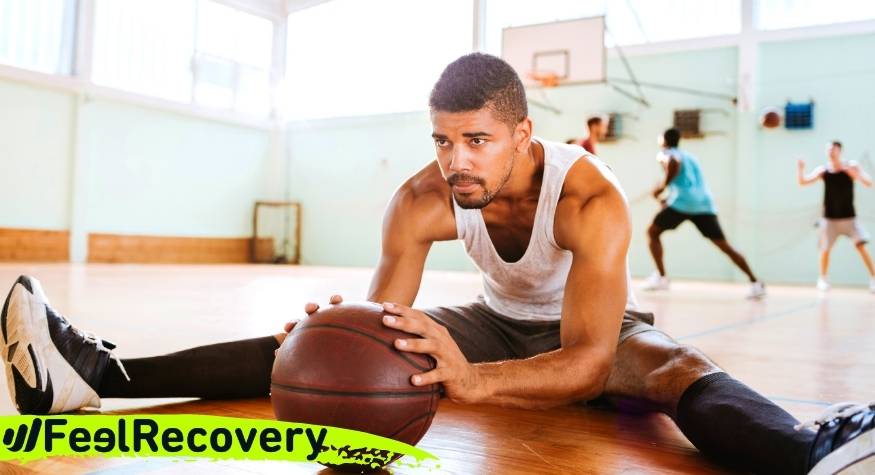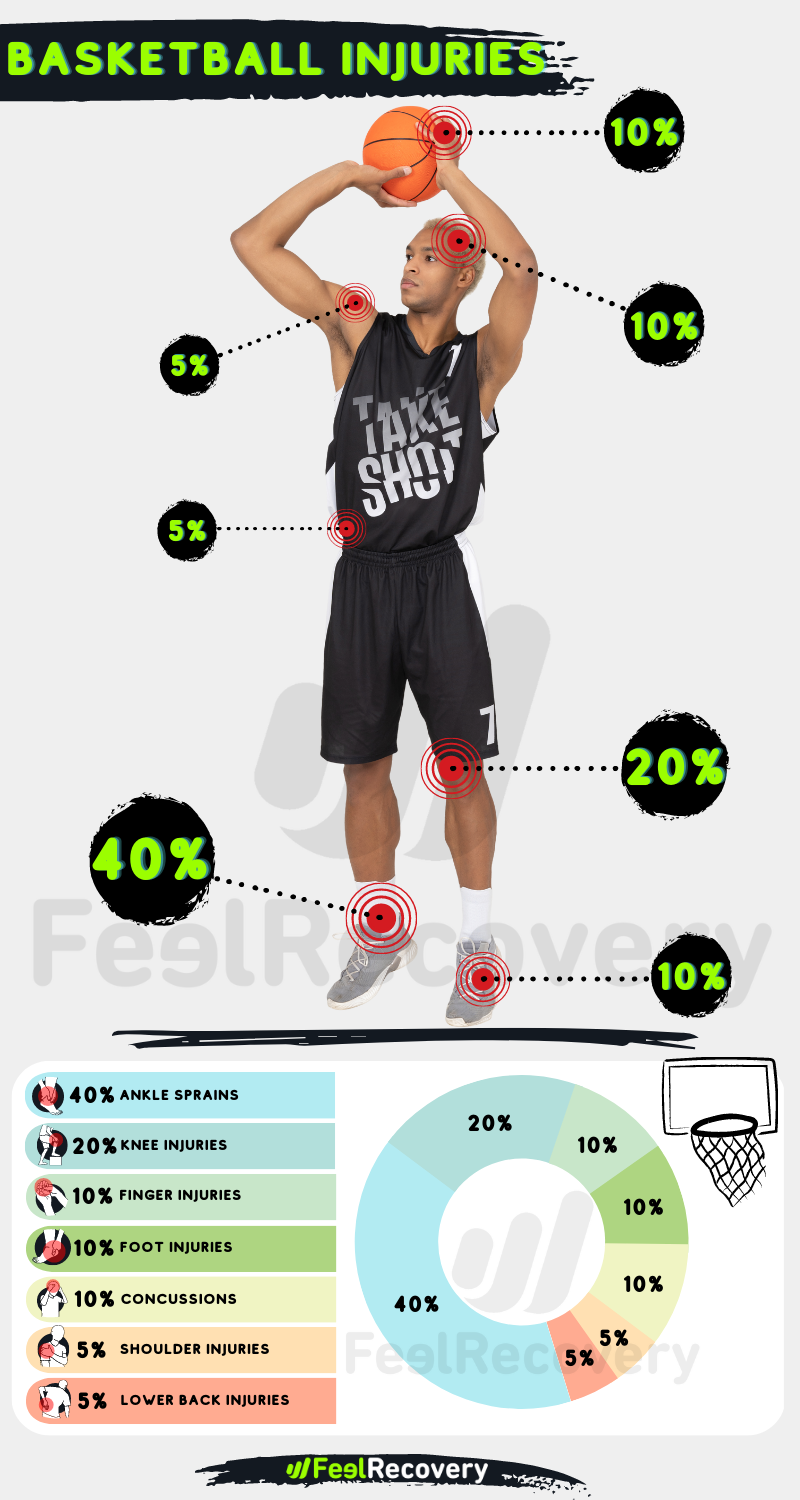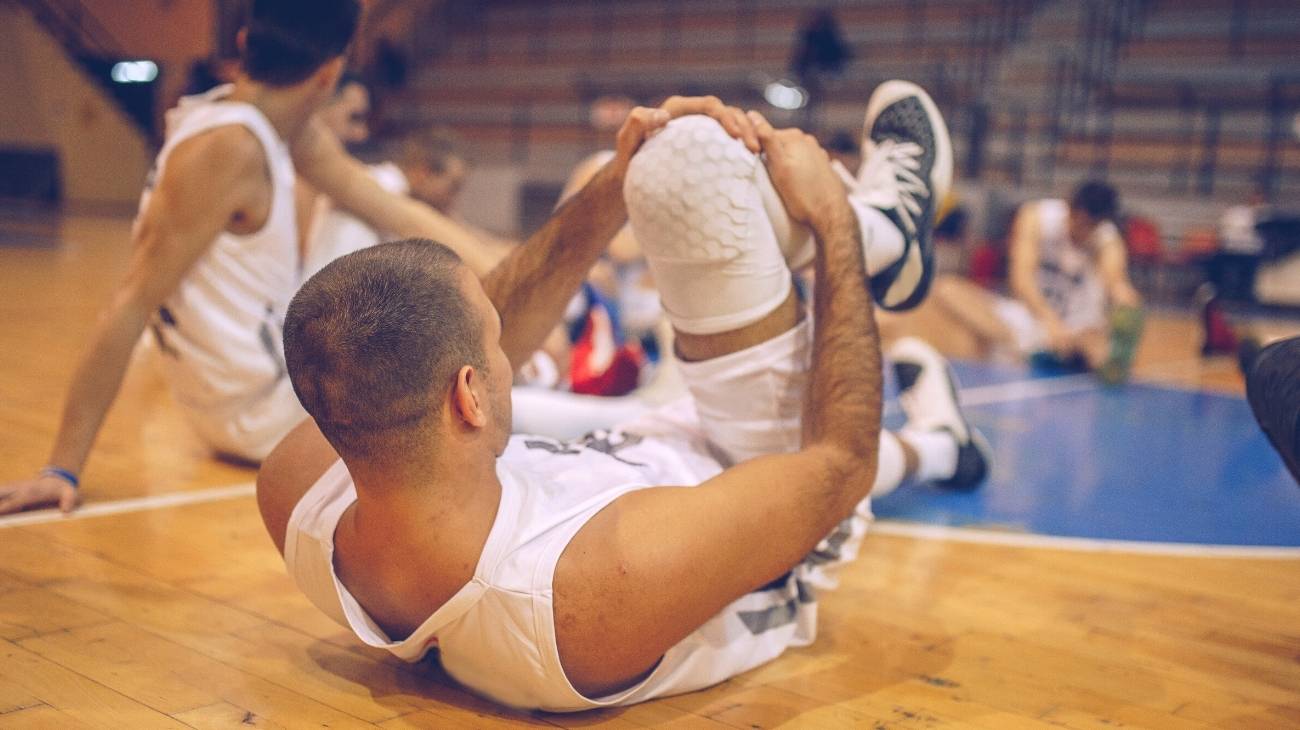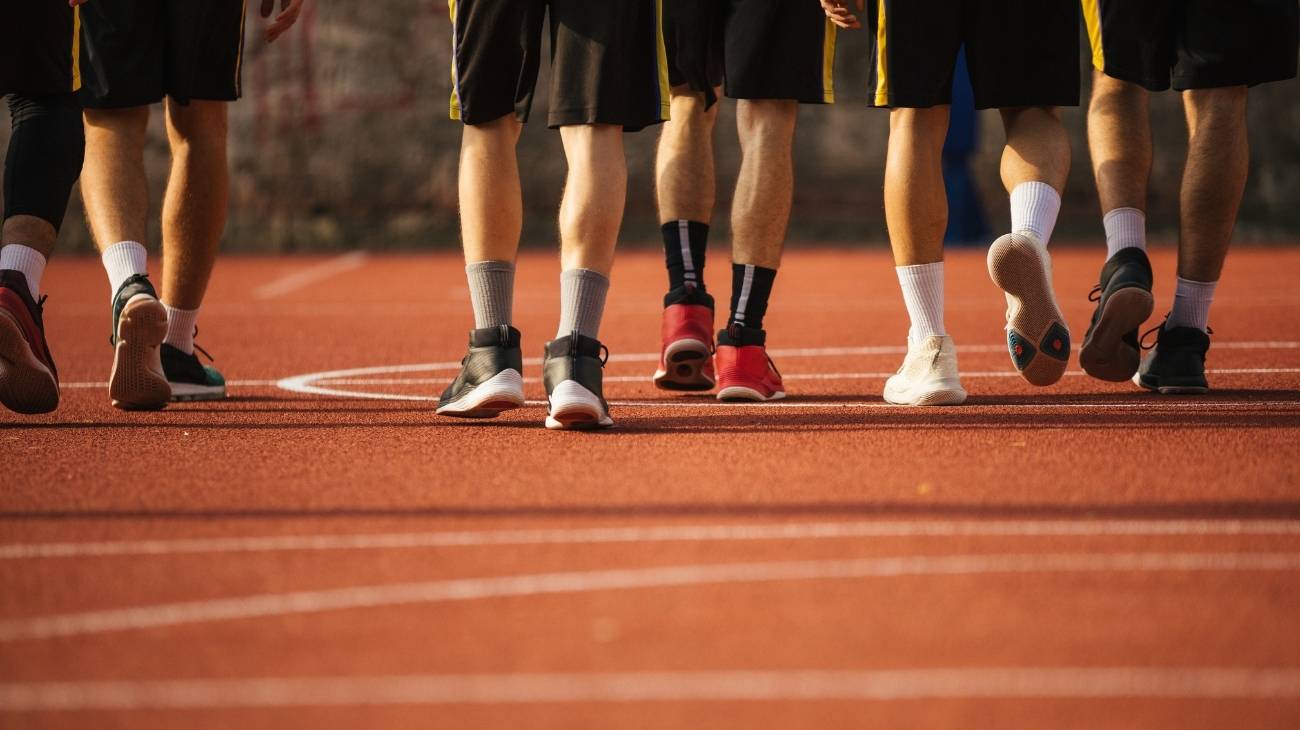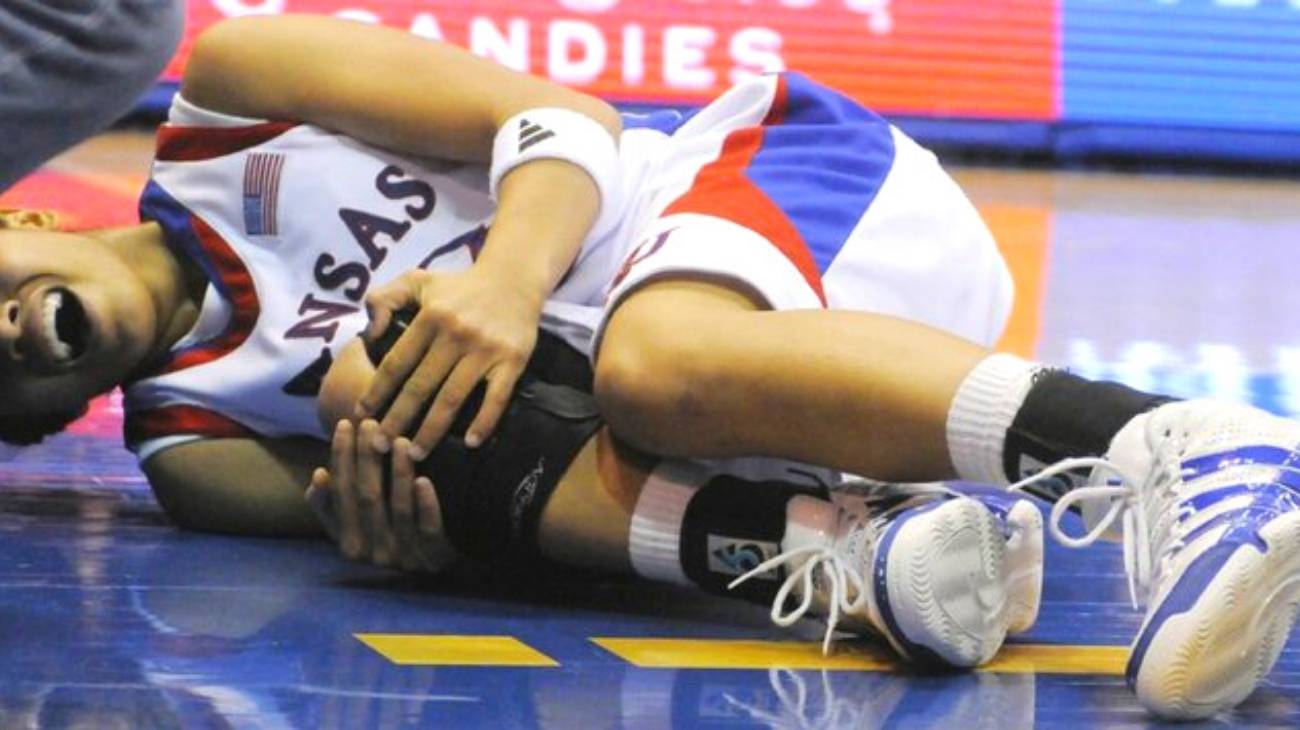Most basketball injuries occur in the legs and there is little difference between injuries sustained in training and in competition, except for the severity of the injuries (more serious injuries tend to be recorded in competition).
In this article we will show you the most common types of basketball injuries, how to prevent them and how to apply the PRICE therapy as a form of first aid. This is a complete guide to everything you need to know about them.
What are the most common types of basketball injuries?
Basketball today is a more intense sport, requiring speed and muscle strength, so injuries are quite common, and more than 40% of these are to the knees and ankles.
Hand and wrist injuries
The hands and wrists are the area where more than 30% of basketball injuries are recorded. Most of them are minor and do not require professionals to stop physical activity, but a doctor should always be consulted after suffering one.
- Finger injuries: frequently occur in the joints of the fingers closest to the knuckles, mainly due to receiving a bad pass from a teammate or intercepting an opponent's pass with the hand in the wrong position. Injuries range from ligament damage and tendonitis to small fractures that require complete cessation of physical activity. Finger injuries account for 16% of all injuries sustained by basketball players.
- Thumb fracture: the base of the metacarpal may crack (fracture) and there may be an injury to the ulnar collateral ligament. This is caused by poor ball handling. The player's hand should have training to strengthen it and prevent it from suffering from the demands of sport.
- Hand lacerations: the probability of a fall in basketball is high, so it is not excluded that there will be broken skin on the hands due to the strong contact with the floor or any hard surface. Depending on the type of laceration, the tendons, vessels and nerves of the fingers may be severely affected.
- Tendonitis of the wrist: the tendon of the extensor carpi ulnaris muscle is injured by repetitive movements of the wrist when handling the ball. There may be inflammation of this tendon and pain focused on the back of the hand. Although not usually a factor in coming out of a game, it does limit the movement of the hand and in turn the athlete's performance.
Knee injuries
The knee is an essential joint for any athlete, especially for basketball players who require it both for movement and for jumping when scoring.
- Torn ligaments: This is a recurring condition in sports where there is constant starting and stopping of players. In the case of basketball, an accidental collision with another player or a sprain when falling badly after a jump are the main reasons why knee ligaments are torn. These ligaments are: internal medial collateral, external collateral, anterior cruciate and posterior cruciate. Surgical intervention will almost always be necessary.
- Meniscus tear: This condition is linked to the previous one, because when the knee is left without the strength of the tendons, unprotected by stabilisers, the structure of the shock absorbers such as the meniscus breaks down. As they do not function properly, even the articular cartilage is affected. The further the injury progresses, the more complex it will be to return to physical activity in a short time.
- Patellar tendonitis: The function of the patellar tendon is to attach the calf muscle to the bone. When this is overloaded, tendonitis is likely to develop. The pain is even felt in the tibia and is aggravated by improper movements or failure to receive immediate first aid using the PRICE therapy. This is the result of accumulated wear and tear from jumping to score, which is why this injury is also known as "jumper's knee".
- Hamstring tear: The hamstrings are located at the back of the thigh and facilitate the movement of the leg. Changes in the pace of play and training in basketball cause the muscle to wear down and the hamstring to tear. Surgical intervention is avoided as much as possible and non-invasive treatments are chosen, but this decision will always be made by a specialist.
- Knee sprain: If the knee is in a bad position when taking a kick-off, or when returning to the ground after a jump to block a shot or score, an unnatural movement can cause the knee ligaments to overextend, leading to a sprain. Sprains can range in severity from a simple sprain with swelling to a complete tear of the ligaments in the joint.
Ankle, foot and leg injuries
Like the knees, the feet and ankles represent one of the most injured areas in basketball, which is why thorough preparation is needed to strengthen them.
- Sprained ankle: A bad fall while jumping for the ball is reason enough for a sprained ankle. It is more common than it seems when the player is inexperienced. Almost 30% of basketball injuries are sprained knees and ankles. As sprains can be recurrent, the medial or lateral ligaments may be more affected and require physiotherapy or, in the worst case, surgery.
- Achilles tendonitis: This affects the back and lower part of the calf, where the leg joins the foot. It is caused by an overload of stress on this area of the body. When the tendon is overstretched, it generates severe pain and inflammation that makes it necessary to stop physical activity immediately. It is the result of the constant pivoting and braking that players do on the pitch during a match.
- Plantar fasciitis: The feet absorb the shock of the player's fall. During games, players jump several times in search of the ball and to take shots. However, they leave significant wear and tear on the fascia, a tissue that runs along the sole of the foot, which becomes inflamed causing acute pain.
- Compartment syndrome in the legs: This is a problem in the blood circulation in the legs that ultimately leads to damaged muscles and nerves. It is caused by trauma and severe sprains and strains that were not properly treated. As a consequence there is a strong pressure inside the muscles and it makes them much more fragile and sensitive to injury.
Best products for basketball injury recovery
Bestseller
-
2 Ankle Compression Sleeve (Black/Gray)
$19.95 -
2 Ankle Compression Sleeve (Green/Navy)
$19.95 -
2 Ankle Compression Sleeve (Pink/Bordeaux)
$19.95 -
2 Calf Compression Sleeve (Black/Gray)
$19.95 -
2 Calf Compression Sleeve (Green/Navy)
$19.95 -
2 Calf Compression Sleeve (Pink/Bordeaux)
$19.95 -
2 Elbow Compression Sleeve (Black/Gray)
$19.95 -
2 Elbow Compression Sleeve (Green/Navy)
$19.95 -
2 Elbow Compression Sleeve (Pink/Bordeaux)
$19.95 -
2 Knee Compression Sleeve (Black/Gray)
$19.95 -
2 Knee Compression Sleeve (Green/Navy)
$19.95 -
2 Knee Compression Sleeve (Pink/Bordeaux)
$19.95 -
2 Patella Knee Strap (Black/Gray)
$14.95 -
2 Patella Knee Strap (Green/Navy)
$14.95 -
2 Patella Knee Strap (Pink/Bordeaux)
$14.95 -
2 Thigh Compression Sleeve (Black/Gray)
$19.95 -
2 Thigh Compression Sleeve (Green/Navy)
$19.95 -
2 Thigh Compression Sleeve (Pink/Bordeaux)
$19.95 -
Acupressure Mat and Pillow (Black/Gray)
$49.95 -
Acupressure Mat and Pillow (Green/Navy)
$49.95 -
Acupressure Mat and Pillow (Pink/Bordeaux)
$49.95 -
Acupressure Pillow (Black/Gray)
$29.46 -
Acupressure Pillow (Green/Navy)
$29.46 -
Acupressure Pillow (Pink/Bordeaux)
$29.46 -
Foot Massage Roller for Plantar Fasciitis (Black)
$19.95 -
Foot Massage Roller for Plantar Fasciitis (Green)
$19.95 -
Foot Massage Roller for Plantar Fasciitis (Pink)
$19.95 -
High Density Foam Roller for Muscle (Black/Gray)
$29.95 -
High Density Foam Roller for Muscle (Green/Navy)
$29.95 -
High Density Foam Roller for Muscle (Pink/Bordeaux)
$29.95 -
Ice Massage Roller Ball (Black)
$39.95 -
Ice Massage Roller Ball (Green)
$39.95 -
Ice Massage Roller Ball (Pink)
$39.95 -
Microwaveable Heating Pad for Pain Relief (Hearts)
$19.95 -
Microwaveable Heating Pad for Pain Relief (Oxford)
$19.95 -
Microwaveable Heating Pad for Pain Relief (Sport)
$19.95 -
Pack 2 In 1 Foam Roller High + Soft Density (Black/Gray)
$29.95 -
Pack 2 In 1 Foam Roller High + Soft Density (Green/Navy)
$29.95 -
Pack 2 In 1 Foam Roller High + Soft Density (Pink/Bordeaux)
$29.95 -
Shoulder Support Brace (Black)
$24.95 -
Shoulder Support Brace (Green)
$24.95 -
Shoulder Support Brace (Pink)
$24.95 -
Soft Density Foam Roller for Recovery (Black)
$29.95 -
Soft Density Foam Roller for Recovery (Green)
$29.95 -
Soft Density Foam Roller for Recovery (Pink)
$29.95 -
Sport Compression Socks (1 Pair) (Black/Gray)
$19.95 -
Sport Compression Socks (1 Pair) (Green/Navy)
$19.95 -
Sport Compression Socks (1 Pair) (Pink/Bordeaux)
$19.95 -
Trigger Point Massage Stick (Black)
$14.95 -
Trigger Point Massage Stick (Green)
$14.95 -
Trigger Point Massage Stick (Pink)
$14.95 -
Wrist Brace (Black/Gray)
$19.95 -
Wrist Brace (Green/Navy)
$19.95 -
Wrist Brace (Pink/Bordeaux)
$19.95
How to prevent injuries when playing basketball?
On average, a basketball player can sustain an injury every thousand hours. Many injuries can be prevented during training and with alternative therapies
- Warming up well: the best warm-up for a basketball player will always be progressive. For example, there should be a general phase in which alternating jogging activates the cardio respiratory system. While jogging, lift your knees as high as possible, then lift your heels as high as possible. This should only last for a few minutes as we prepare for the specific workout. Gradually rotate your hips and move your arms to stretch them.
- Finish your workouts with a cool-down: these are light exercises that allow the body to gradually return to its resting state. The heart rate and blood circulation are thus regularised without generating negative effects. Cooling down also prevents dizziness due to the accumulation of blood in the lower extremities. As the veins are thickened by sporting activity, they should return to their natural size. Walking for about 20 minutes is excellent as it gives mobility to all muscles.
- Good nutrition and hydration: as basketball players must be fast, strong and resistant, the diet must cover all these aspects. This is why a strategy is designed so that you eat at least five times a day, in small quantities, as more nutrients need to be absorbed by your body and this is best achieved by eating more times a day. A good diet contains sufficient carbohydrates and electrolytes, it is preferable that during training sessions the diet is more strictly adhered to, because before a match the body should already have the nutrients it requires. The intake of fats and fried foods should be low, as they are digested slowly and create a feeling of heaviness.
- Improve your physical condition: it is not about height but endurance, the higher you are the harder it is for the body to remain stable, so much of the training should be focused on the endurance of the players. In addition, muscle power must be trained in order to perform those explosive short bursts that are so characteristic of basketball after a steal.
- Sports massage: in basketball there are pre-competitive massages and injury recovery massages. As their names indicate, the former is done to get the body in shape for a game. With it we stimulate the musculature and the associated nervous system, increase muscle tone and increase blood flow. What is its ultimate purpose? To eliminate muscle fatigue and prevent injuries. On the other hand, recovery massages are applied in order to return as quickly as possible to the courts and to grow as an athlete. These massages promote the physical and mental recovery of the athlete.
- Use of hot and cold therapies: the use of these therapies should be temporary, either to prepare the body before training or to relieve pain after an injury. The cold serves to vasoconstrict the blood capillaries. What is desired is that less blood reaches the joints where the cold compress is applied. It also works as an anti-inflammatory. The application of heat can be with bags, bags or electric blankets that keep the body in shape for further training. Prolonged use also leaves negative consequences that we must deal with.
- Use of compression garments: A good purpose of compression garments is to keep the muscles active and to activate blood circulation. In the mid-1990s, the garments were used as a post-traumatic treatment for their ability to reduce pain and swelling.
- Use of acupressure therapies: As in any sport, acupressure aims to eliminate tensions in the joints and muscles where an injury has been detected. This technique achieves a 61% better recovery, provided that the sports doctor recommends it. Not all injuries can be treated in the same way. There are mats and other products on the market that offer acupressure experiences, but it is best to have a physiotherapist apply this technique with their fingers and palms. Unlike acupuncture, acupressure does not use needles, although the principles and point locations are the same.
- Use of thermotherapy and cryotherapy: the difference with the cold and heat therapies that we usually use superficially, in thermotherapy and cryotherapy specific supplies and technology are used according to the part of the body to be treated. In addition, other times are used, several sessions spread over one or two weeks. Another big difference is that long-term results are expected, it is not simply a matter of reducing inflammation or relieving a specific pain. In cryotherapy we expose the body to an environment of approximately -110°C and -140°C. The time is no more than three minutes and the treatment time is no longer than three minutes. The time is no more than three minutes and allows the body to recover from chronic injuries and treat inflammation that has lasted longer than expected.
- Use of appropriate equipment: It is not enough for the clothing to be loose and light, it must have a breathable fabric, which favours the channelling of sweat so that the player does not feel uncomfortable. T-shirts are sleeveless, although players already prefer to wear compression garments that simulate long-sleeved flannels. The shorts are short, above the knee so as not to limit explosive movement and rotation at the pivot. Like the jerseys, they used to be made of cotton, but now we see them made of synthetic material.
How to apply the RICE therapy to treat first aid injuries in basketball?
As the highest percentage of injuries occur in the legs and arms, the whole therapy should be focused on first aid care in these areas of the body.
- Protection: this is based on the immobilisation of the affected area, either with bandages, orthoses and splints. This protection serves to stabilise and correct the functional aspects of a joint.
- Rest: immediately after the injury, muscle activity must be stopped and the patient must wait several days, according to the doctor's instructions, to find out how to return to movement. Sometimes re-injury is caused by not taking adequate rest.
- Ice: try not to get the ice in direct contact with the skin, burns are a possibility if this happens. Bleeding is also minimised by the application of ice packs. Use ice for 10 to 20 minutes, depending on the results and the reaction of the injury instantly.
- Compression:with light pressure on the discomfort we cut off the blood supply. It is preferable to use a bandage that is tight, but without too much pressure. These bandages can also be used to immobilise a minor injury.
- Elevation: keeping the affected limb elevated is an age-old recipe for reducing pain, blood pressure and inflammation. It uses the force of gravity to your advantage. If you are at home, use pillows or a soft surface on which you can place your foot or arm.
References
- Harmer, P. A. (2005). Basketball injuries. Epidemiology of pediatric sports injuries: Team sports, 49, 31-61. https://www.karger.com/Article/Abstract/85341
- Newman, J. S., & Newberg, A. H. (2010). Basketball injuries. Radiologic Clinics, 48(6), 1095-1111. https://www.radiologic.theclinics.com/article/S0033-8389(10)00121-1/fulltext
- Trojian, T. H., Cracco, A., Hall, M., Mascaro, M., Aerni, G., & Ragle, R. (2013). Basketball injuries: caring for a basketball team. Current sports medicine reports, 12(5), 321-328. https://journals.lww.com/acsm-csmr/Fulltext/2013/09000/Basketball_Injuries___Caring_for_a_Basketball.13.aspx
- Borowski, L. A., Yard, E. E., Fields, S. K., & Comstock, R. D. (2008). The epidemiology of US high school basketball injuries, 2005–2007. The American journal of sports medicine, 36(12), 2328-2335. https://journals.sagepub.com/doi/abs/10.1177/0363546508322893
- Zelisko, J. A., Noble, H. B., & Porter, M. (1982). A comparison of men's and women's professional basketball injuries. The American journal of sports medicine, 10(5), 297-299. https://journals.sagepub.com/doi/abs/10.1177/036354658201000507
- Dick, R., Hertel, J., Agel, J., Grossman, J., & Marshall, S. W. (2007). Descriptive epidemiology of collegiate men's basketball injuries: National Collegiate Athletic Association Injury Surveillance System, 1988–1989 through 2003–2004. Journal of athletic training, 42(2), 194. https://www.ncbi.nlm.nih.gov/pmc/articles/PMC1941286/
- Bolotin, A., & Bakayev, V. (2016). Efficacy of using isometric exercises to prevent basketball injuries. Journal of Physical Education and Sport, 16(4), 1177. http://efsupit.ro/images/stories/nr4.2016/art188.pdf
- Padua, E., D’Amico, A. G., Alashram, A., Campoli, F., Romagnoli, C., Lombardo, M., ... & Annino, G. (2019). Effectiveness of warm-up routine on the ankle injuries prevention in young female basketball players: a randomized controlled trial. Medicina, 55(10), 690. https://www.mdpi.com/1648-9144/55/10/690
- Sonzogni Jr, J. J., & Gross, M. L. (1993). Assessment and treatment of basketball injuries. Clinics in sports medicine, 12(2), 221-237. https://europepmc.org/article/med/8481963
- McKay, G. D., Goldie, P. A., Payne, W. R., Oakes, B. W., & Watson, L. F. (2001). A prospective study of injuries in basketball: a total profile and comparison by gender and standard of competition. Journal of Science and Medicine in Sport, 4(2), 196-211. https://www.sciencedirect.com/science/article/abs/pii/S144024400180030X
























































































